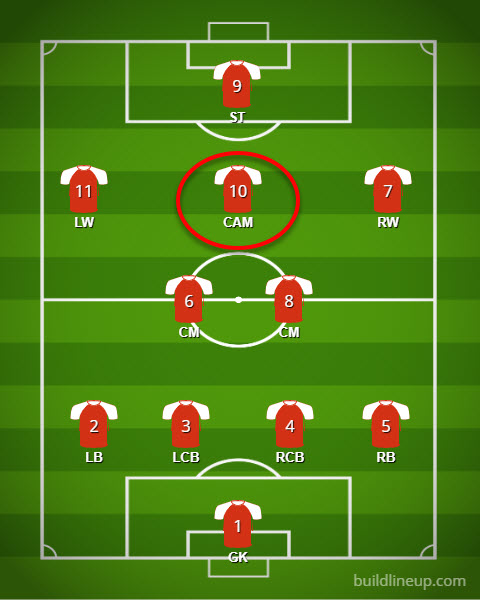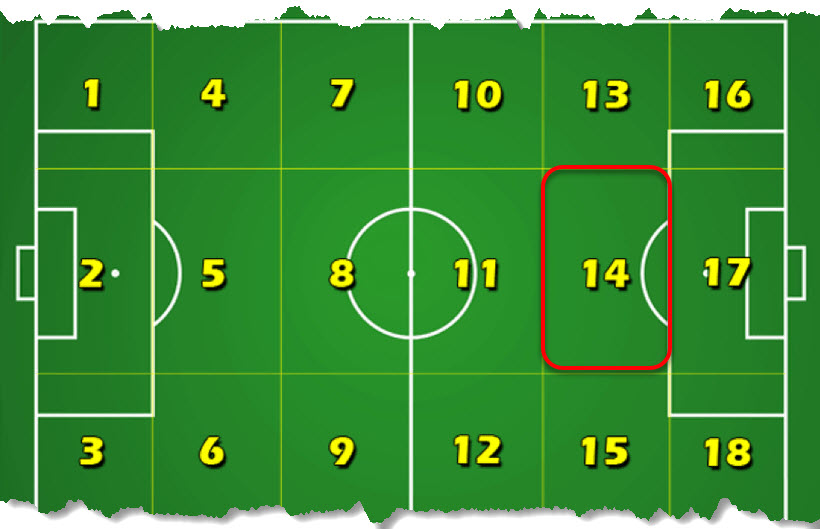If you’re new to soccer, then you might struggle to keep up with the list of abbreviations for all the different facets of the sport.
But worry not!
Here at SoccerWhizz, we continuously strive to enlighten and inform our readers so you’re in safe hands.
Now, one of the most misunderstood soccer positions that draws so much attention from pundits and casual fans alike is that of the CAM.
To start with, what does this term even mean?
Well…
A CAM in soccer refers to a Central Attacking Midfielder, whose on-field position is situated behind the striker. They take on more attacking responsibilities than a traditional central midfielder would.
Lots of soccer analysts prefer to use this short form as it simplifies identification and allows for easier referencing.
Read on to learn more about the ins and outs of this soccer position.
Where does a CAM play on the pitch?
As alluded to in the introductory part of the article, the center attacking midfielder typically positions themself between the strikers and the central midfielders.
You can take a look at the diagram below to gather a better understanding of their average position on the pitch.

Most soccer teams these days deploy a general 4-2-3-1 formation that consists of:
- Four defenders;
- Two central midfielders;
- Two wingers;
- One central attacking midfielder; and
- One striker
From this setup, you can expect a good central attacking midfielder to roam around what is called zone 14.
This is the area in the middle of the pitch that’s situated just outside an opposing team’s penalty box.
Plenty of statistical data gathered during the ‘90s and onwards showed that the most successful teams produced high levels of attacking performance within this so-called zone 14.
For example, a group of researchers studied the output of successful and unsuccessful teams at the 1998 World Cup.
They concluded that zone 14 was an area of excellence for the central attacking midfielder.
In particular, they chose to highlight Zinedine Zidane’s world class performances in this area of the field that contributed greatly towards France lifting the FIFA World Cup trophy as eventual winners.
How do you play as a CAM in soccer?
The center attacking midfielder will act as the connecting link between the rest of the midfield and the forward line.
So, they can be expected to drop deeper into their own territory to pick up the soccer ball, after which they’d either try and distribute a short or long pass to a wide player or striker.
Alternatively, if the central attacking midfielder is part of a winning team that holds a comfortable scoreline lead, they’d more likely recycle possession by passing backwards to central midfielders, defensive fullbacks or wingbacks.
On the other hand, the more skillful central attacking midfielders will be capable of picking the ball up in between the left- and right-sided defensive half space pockets, before driving towards the opposition goal with close control dribbling.
Lionel Messi is perhaps the greatest example of a player who can execute this technique.
You can also take a look a the video below, which offers a great breakdown of how to perform in this role:
What attributes does a CAM need to thrive in soccer?
The central attacking midfield spot is a very demanding position that can only be effectively filled by players who match up to its physical and technical specifications.
Down below are some of the qualities needed to excel in this role:
1. Creativity
Most of the teams that use a central attacking midfielder will release most of the attacking burden onto this player.
He or she will generally act as the focal point for attacking moves, meaning that most of the forward impetus can be expected to originate from them.
Such demands call for players in this position to be creative.
If an opposition team has lodged nine or more men behind the ball, the central attacking midfielder will need to find an imaginative way of unlocking that defense.
This could mean threading a perfectly weighted through ball into the forward channels for a striker to run on to, or it could simply mean beating a man with a clever piece of ball trickery that leaves them with the space to have a shot at goal.
2. Agility
A lot of the time, a central attacking midfielder will receive the soccer ball with their back facing towards the opposition goal.
This is one of the hardest ways to keep control of a ball because it’s very easy for an onrushing defener to nick the ball away just before possession is achieved.
So, central attacking midfielders need to be physically agile enough, as this trait will allow them to beat defenders with quick half-turns and sharp changes of direction.
Players can build up their agility with basic gym work, as exercises like bleep tests nurture their ability to move from one point to another with rapid speed.
3. Vision
You could have all the passing ability in the world.
But that raw quality won’t get you far without the skill of being able to see attacking runs and coordinated movements from your teammates before they’re even made.
That’s what having good vision is all about – having the eye to spot a great passing opportunity.
4. Decision making
What arguably separates the good central attacking midfielders from the excellent ones is their ability to make the correct decisions at the right times.
One of the criticisms aimed at Manchester United’s Bruno Fernandes is that he’s wasteful in possession, even though the Portuguese man is widely regarded as the team’s best talent.
You’ll often catch him making a string of errant passes to opposition players, and part of that is due to his sometimes poor decision making.
Central attacking midfielders with good skill in this area won’t rush their passes and they’ll know when to wait for a passing chance, as well as the opportune moment to immediately follow through with a threaded ball.
5. Spatial awareness
This is one of the key attributes that a quality central attacking midfielder should have within their arsenal.
What this involves is knowing exactly where your teammates are positioned on the pitch, not to mention having good coordinates on where opponents are.
A lot of the central attacking midfielders that perform a playmaking role find pockets of space to operate in where they will be at their most dangerous.
Commentators even refer to this phenomenon during matches as “playing in the hole”, and as such you can expect the top performers of this technique to be able to make themselves available in acres of space where they can penetrate the opposition defense.
Spatial awareness is an attribute that can be improved with consistent game time, although the best central attacking midfielders have fantastic peripheral vision ingrained within them.
What this means is that they know where other people are on the field in relation to where the ball is located and how the phase of play is transitioning, not to mention knowing exactly how and when to take advantage of lapses in concentration that create exploitable spaces.
6. Composure
This position demands a cool head and a calmness on the ball.
Because opposition players try to deny spaces and opportunities at every chance they get, this can sometimes leave attacking players frustrated if they’re struggling to break down a resilient defense.
A composed central attacking midfielder will remain undisturbed and undeterred from achieving their performance objectives.
They will demonstrate quick thinking when posed with the pressure of an opposition player closing them down.
In addition to that, you won’t be able to ruffle such a player’s disciplinary feathers by hacking them down at every opportunity.
Composed players simply keep their cool and get on with the game in the best way that they know how.
7. Flair
Another quality that makes the best central attacking midfielders stand out is their knack of being unpredictable with their movements.
Defenders aren’t able to plan in advance on how to nullify an attacking threat from a central attacking midfielder if they’re frequently doing the unexpected.
They simply won’t be able to anticipate the next attacking move.
8. Passing
Lastly, a central attacking midfielder has to be able to pass the ball to a good degree of quality.
This involves having a wide passing range to pull off a variety of different ball distribution types, such as:
- Cross field balls;
- Through balls;
- Short passes; and
- Early crosses
Without good passing, wingers will be starved of nicely weighted balls that they can whip into the penalty area, and strikers will struggle to get an ample supply of scoring chances.
And those things in and of themselves affect match results because if a team can’t score, then how can they logically expect to win?
Examples of world class CAMs in soccer
It’s always good to include real life reference points when talking about certain aspects of this sport.
So, here are a few players who arguably set the performance benchmark for how central attacking midfield quality:
Thomas Müller

Once his professional career comes to an end, the German will be considered a legend for both club and country.
Müller’s off the ball movement is potentially second to none, as he knows what areas of the pitch to drive into when his Bayern Munich teammates patiently possess the ball in advanced areas.
He gets into great goal scoring positions with regularity and he’s equally able to vacate space for his colleagues to run into.
Christian Eriksen

The wider soccer world was brought into a state of shock when Erisken collapsed to the ground during a Euro 2020 match that took place between his country Denmark and Finland.
However, after his lengthy recovery and the successful installation of his heart pacemaker, the Dane has managed to regain his best form for Premier League side Brentford.
Eriksen simply knows how to dictate periods of play as a central attacking midfielder; dropping deep to help out in defensive pressing and ball retention when required, along with distributing short and long range passes to his forward teammates.
Will the CAM soccer role exist in the future?
The physical demands of modern soccer are causing teams to focus their tactics away from having central attacking midfielders.
Instead of having one player perform this crucial attacking role, the top clubs are prioritizing well-rounded central midfielders who can contribute both offensively and defensively.
What this means is that use of the central attacking midfield role is gradually on the wane.
For example, look at two of the most successful teams in recent history – Manchester City and Liverpool.
The managers of both these teams prefer to play with two “number 8’s” as opposed to a single “number 10”.
Wrap up
If you’ve enjoyed this article’s insight into what a CAM means in soccer, then you’ll likely love this piece on what a CDM is in soccer too!
If you enjoy the content that I create and would like to buy me a coffee, then I’d really appreciate it!
Any money that I earn through this donation will be re-invested into more content for this website.
Additionally, by sending in a donation you’ll also receive a copy of my recently released 190+ page eBook on Soccer Ball Care, as well as be subscribed to our mailing list where you’ll be regularly informed on the latest developments concerning the Soccer Whizz blog.
- Future Icons: Europe’s Emerging Midfield Maestros Set for Glory - December 4, 2023
- Kickstarting a Revolution: How Soccer Transformed the United States Over the Last Four Years - October 7, 2023
- 4-1-4-1 Soccer Formation [Analysis] - September 23, 2023


